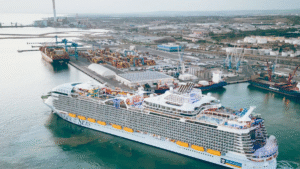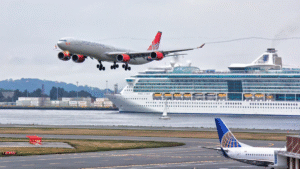Starting your vacation with ease begins with planning your cruise port transfers. Whether you prefer convenience or affordability, selecting the right transfer from the airport to the cruise terminal is crucial. Options abound, but the right choice ensures you arrive directly to my terminal stress-free and on time, ready to embark on your cruise adventure.
Taxis and Rideshares

How to get from the airport to a cruise terminal
Using taxis for transfer to the cruise port
Taxis offer a straightforward and convenient option for cruise port transfers. They are readily available at most airports, allowing you to avoid the hassle of pre-booking. With direct routes to your destination, taxis minimize travel time and eliminate the need for multiple stops. This makes them ideal for travelers who prioritize efficiency.
However, taxis can be costly, especially during peak hours or in cities with high demand. The starting rate for a transfer to the cruise port often begins at $110.00 per group, accommodating up to six passengers. While this price may suit small groups, it can be less economical for solo travelers. Additionally, taxis may have limited space for luggage, which could pose challenges if you’re traveling with bulky items or large suitcases.
Waiting times for taxis vary depending on the airport and time of day. On average, you can expect to wait between 30 to 60 minutes for a standard pickup. For cruise port pickups, the wait may extend slightly longer. If you’re traveling during peak travel seasons, planning ahead can help you avoid delays.
Rideshare services for cruise port transfers
Rideshare services like Uber and Lyft have revolutionized airport transfers. These platforms provide a cost-effective alternative to taxis, especially for solo travelers or small groups. With the ability to book rides directly through an app, you can enjoy the convenience of tracking your driver’s arrival and paying electronically.
Rideshare services often offer tiered pricing options, ranging from budget-friendly rides to premium vehicles. This flexibility allows you to choose a service that aligns with your preferences and budget. For instance, opting for a shared ride can reduce costs, though it may involve additional stops along the way.
One advantage of rideshares is their adaptability to varying group sizes and luggage needs. Larger vehicles, such as SUVs, can accommodate more passengers and baggage, making them suitable for families or groups heading to the cruise terminal. However, during peak travel times, surge pricing may increase costs significantly.
Both taxis and rideshares provide reliable transfer options from the airport to the cruise port. Your choice will depend on factors like budget, group size, and luggage requirements.
Cruise Line Shuttles

How to get from the airport to a cruise terminal1
Booking a shuttle for transfer from the airport to the cruise terminal
Cruise line shuttles provide a reliable and cost-effective way to travel from the airport to the cruise terminal. Many cruise companies, including Princess Cruises, offer dedicated shuttle services to the cruise port. You can book a transfer service directly through the cruise line’s website or by contacting their customer service team. This option ensures that your transportation aligns with your cruise schedule, reducing the risk of delays.
Shuttle services to the cruise port often operate on a fixed schedule, making it easier to plan your arrival. For example, round-trip transportation from Orlando International Airport to Port Canaveral costs approximately $59.98 per person, which breaks down to $30 each way. This pricing is significantly lower than rideshare options, which can range from $70 to $100 for a one-way trip. If you’re traveling with a companion, the total cost for two people using the shuttle service is just under $120, compared to nearly $200 for rideshare alternatives.
Booking a shuttle is straightforward. Most cruise lines allow you to add transportation to your reservation during the booking process. Alternatively, you can arrange it closer to your departure date. By securing your transfer in advance, you can avoid last-minute stress and ensure a smooth journey directly to my terminal.
Advantages and disadvantages of cruise line shuttles
Cruise line shuttles offer several advantages. They are often the most economical choice for solo travelers and small groups. Their fixed pricing eliminates the uncertainty of surge rates, which are common with rideshare services. Additionally, these shuttles are tailored to meet the needs of cruise passengers, ensuring ample space for luggage and a direct route to the terminal.
However, there are some drawbacks to consider. Shuttle services operate on a set schedule, which may not align perfectly with your flight arrival time. This could result in waiting periods at the airport. Furthermore, shuttles typically require advance booking, limiting flexibility for last-minute travelers. If you’re traveling in a large group or prefer a more personalized experience, private transfers might be a better option.
Cruise line shuttles remain a popular choice for cruise port transfers due to their affordability and convenience. By planning ahead and booking early, you can enjoy a stress-free transfer from the airport to the cruise terminal.
Private Transfers
Luxury options for transfer to the cruise port
Private transfers offer an unparalleled level of comfort and exclusivity for your journey to the cruise terminal. These services cater to travelers who value privacy, convenience, and a touch of luxury. Whether you prefer a sleek sedan, a spacious SUV, or even a limousine, private transfer providers ensure a seamless and personalized experience.
The growing demand for luxury travel highlights the appeal of private transfers. Affluent travelers increasingly seek bespoke experiences that prioritize comfort and privacy. The luxury travel market, projected to reach $511.6 billion by 2032, reflects this trend. With private transfers, you can enjoy a direct route to the cruise port without the inconvenience of shared rides or fixed schedules.
Private transfers also provide flexibility. You can customize your pickup time and location to suit your travel plans. This option is particularly beneficial if you’re arriving on a late flight or traveling with a large group. Additionally, these services often include professional chauffeurs who assist with luggage and ensure a stress-free ride.
When private transfers are the best choice
Private transfers are ideal when you prioritize convenience and exclusivity. If you’re traveling with family or a group, the cost per person can become comparable to other options like shuttles. This makes private transfers a practical choice for groups seeking a premium experience.
These services are also perfect for travelers with tight schedules. Unlike shuttles or public transportation, private transfers operate on your timeline. You won’t need to wait for other passengers or adhere to fixed departure times. Furthermore, private transfers are a great option if you’re carrying bulky luggage or require additional space.
For cruise travelers who value a smooth and luxurious start to their vacation, private transfers stand out as a top-tier choice. By booking a transfer service in advance, you can ensure a hassle-free journey to the cruise terminal.
Public Transportation

How to get from the airport to a cruise terminal2
Affordable public transport options for cruise port transfers
Public transportation offers a budget-friendly way to reach the cruise terminal from the airport. Many cities with cruise ports have Ground Transportation Centers (GTC) that consolidate services like buses, shuttles, and trains. These centers reduce travel times by minimizing stops and streamlining operations. They also provide staffed kiosks and counters, making it easier for you to compare fares, schedules, and services.
The proximity of cruise terminals to major airports, train stations, and highways enhances the accessibility of public transport. For example, some cities offer direct train or bus routes from the airport to the terminal, eliminating the need for additional transfers. This convenience makes public transportation a cost-effective choice, especially for solo travelers or those with light luggage.
Using public transportation also reduces traffic congestion and vehicle emissions around the terminal. By choosing this option, you contribute to a more sustainable travel experience while saving money on your cruise port transfer.
Challenges of using public transportation to reach the terminal
Despite its affordability, public transportation presents several challenges for cruise port transfers. Congestion is a significant issue, particularly during peak hours when large numbers of passengers arrive at once. This can lead to delays and overcrowded buses or trains, making your journey less comfortable.
Many cruise terminals lack adequate public transport options, forcing travelers to rely on taxis or rideshares. This increases traffic in urban areas and adds to your travel costs. Additionally, navigating public transportation systems can be confusing, especially if you’re unfamiliar with the city or traveling with heavy luggage.
Research highlights that inadequate transport services near cruise terminals often fail to meet the demand during peak times. This can result in longer wait times and missed connections, adding stress to your travel experience. If you’re considering public transportation, planning ahead and checking schedules can help you avoid these pitfalls.
Rental Cars
Renting a car for transfer from the airport to the cruise terminal
Renting a car offers flexibility and independence for your transfer from the airport to the cruise terminal. This option is particularly appealing if you plan to explore the area before boarding your cruise. Many rental agencies, such as Enterprise, Budget, and Avis, operate near major airports, making it easy to pick up a vehicle upon arrival.
The car rental market thrives on airport transport demand, driven by the growing number of travelers and increased air traffic. This trend highlights the viability of rental cars for airport-to-cruise transfers. However, rental costs can vary significantly depending on the location. For instance, transfers from Port Canaveral have seen price increases, with rates now at $39 per person. In contrast, other locations like Copenhagen and Civitavecchia have experienced cost reductions, making them more budget-friendly.
When renting a car, consider factors like group size, luggage space, and rental duration. One-way rentals are a popular choice for cruise passengers, allowing you to drop off the car near the terminal without the need to return it to the original location. While this convenience often comes with a one-way fee, it can save time and effort.
Drop-off locations near the terminal
Most major rental agencies provide drop-off locations close to cruise terminals, ensuring a seamless transition to your ship. For example, at Port Canaveral, agencies like Budget and Avis offer shuttle services to the terminal. These shuttles typically run every 25 minutes, making it easy to reach your destination.
Travelers have shared positive experiences with these services. One user noted that dropping off their rental car at Budget around 9:00 am was straightforward, and the shuttle to the port was convenient despite some timing restrictions. To avoid confusion, confirm shuttle schedules in advance.
If you’re considering a rental car for your transfer, research the available agencies and their proximity to the terminal. This ensures you can drop off the car and board your cruise without unnecessary delays.
Cruise port transfers simplify your journey to the terminal, offering options tailored to your needs. Whether you choose taxis, shuttles, or public transportation, each method ensures a smooth start to your cruise. Planning ahead lets you avoid delays and focus on enjoying your vacation. Select the option that fits your schedule and budget.


